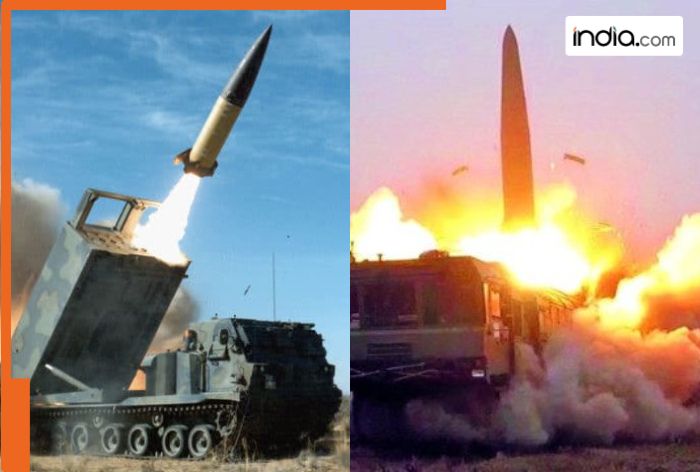Russian Iskander vs US-made ATACMS, the missiles used in Russia-Ukraine war, which is more deadlier? EXPLAINED

Both the ATACMS (Army Tactical Missile System) and Russia’s Iskander missiles are being extensively used in the ongoing Russia-Ukraine war. Designed for precision strikes over long distances, these missiles have become critical tools in the conflict. Russia has the advantage of manufacturing its own missiles, while Ukraine relies on American-supplied ATACMS.
The U.S. has provided ATACMS missiles to Ukraine to enable strikes deep within Russian territory. Ukraine has already used these missiles effectively, prompting Russia to retaliate with its advanced hypersonic missiles, targeting Ukrainian military industries in Dnipro. Meanwhile, Russia continues to deploy its lethal Iskander missiles in the war.
Let’s compare the two to determine which is more powerful.
What is ATACMS?
ATACMS (Army Tactical Missile System) is a supersonic tactical ballistic missile with the codename MGM-140. Measuring 13 feet in length, it operates on a solid propellant and has a diameter of 24 inches. With a range of 300 km, it allows Ukraine to target critical locations deep within Russian territory when launched from its borders.
This missile can be launched from two platforms:
M270 Multiple Launch Rocket System (MLRS)
M142 High Mobility Artillery Rocket System (HIMARS)
ATACMS is currently used by countries including the U.S., Australia, South Korea, Morocco, Romania, Greece, Turkey, Poland, Ukraine, and the UAE. Before the Russia-Ukraine conflict, it had been deployed in major wars like the Gulf War and the Iraq War.
Ukraine possesses several ATACMS batteries, each launcher capable of holding six missiles. There are 11 variants of this missile, tailored for both land and maritime warfare. Weighing 1,670 kg, ATACMS can reach an altitude of up to 50 km and hit targets at a speed of 3,704 km/h. It is equipped with heat fragmentation and penetration warheads, making it a formidable weapon.
Is Iskander the True ‘Sikander’ (Victor) of War?
The Iskander missile is a short-range ballistic missile officially known as 9K720 Iskander. With a range of 500 km, it was introduced by Russia in 2020 to replace the older OTR-21 Tochka missiles. It is currently in service with Russia, Armenia, Algeria, and Belarus.
Iskander’s longer range and modern technology make it a critical part of Russia’s arsenal, and its deployment in the Ukraine war has demonstrated its destructive capability.
Both missiles are powerful in their own right, but their effectiveness depends on the specific battlefield conditions and strategic deployment.
Specifications of Iskander Missile
Weight and Dimensions:
Total weight: 3,800 kg
Length: 24 feet
Diameter: 3 feet
Payload Capacity:
Can carry warheads weighing 480 to 700 kg.
Supports six types of warheads, including:
1. Thermonuclear Weapons: Capable of delivering nuclear devastation.
2. High-Explosive Fragmentation: For creating massive explosions.
3.Submunitions: Releases smaller explosives to maximize impact.
4. Penetration Warhead: Designed to destroy bunkers or buildings.
5. Fuel-Air Explosives: Creates a large blast wave by dispersing fuel and igniting it.
6. Electromagnetic Pulse (EMP): Capable of disrupting electronic systems.
Range and Speed
Covers 400–500 km, making it highly effective for medium-range operations.
Travels at 2 km per second, equating to an astonishing speed of 7,285.32 km/h.
At such velocity, evading an Iskander missile is nearly impossible.
Guidance and Accuracy
The missile uses multiple navigation systems for precise targeting:
Inertial Guidance
Optical DSMAC (Digital Scene Matching Area Correlation)
TERCOM (Terrain Contour Matching)
GPS
GLONASS (Russia’s satellite navigation system)
Accuracy: The missile’s circular error probability (CEP) is 1 to 30 meters, ensuring that even a slight deviation still results in significant destruction.
ATACMS and Iskander: Comparison
Feature
ATACMS
Iskander
Range
300 kilometers
500 kilometers
Speed
Subsonic
Hypersonic
Guidance System
GPS and Inertial
Optical and Inertial
Warhead Capability
Conventional, Cluster Bomb
Conventional, Nuclear, Cluster Bomb
Flexibility
High accuracy, but limited range
Superior speed and extended range
The Iskander missile is technically more lethal in this comparison, as its range, speed, and hypersonic capabilities surpass those of the ATACMS. However, the GPS-guided precision of ATACMS makes it suitable for strategic strikes.
Why Does Russia Have an Edge?
Russia can produce Iskander missiles domestically and replenish them easily.
Ukraine relies on importing ATACMS from the U.S., limiting its availability and quantity.





